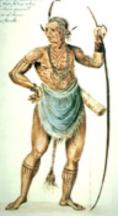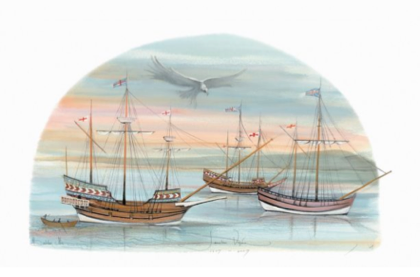
Early on the morning of April 26, 1607 a heavy fog lay across the mouth of the mighty river that flowed passed the villages of the Powhatan Confederacy. That morning Brave Bear, a young Powhatan, was at his favorite spot on the river, spearing the big fish that swam in the dancing waters that extended beyond the rising sun. The silence on the river was broken as strange voices drifting across the water. These voices were different from any spoken by the many friendly tribes living nearby. Brave Bear decided to wait by the river bank until the fog had disappeared. Then he would return to his village and tell Chief Wahunsunacock everything he had seen. The wise Powhatan chief would know what to do.
An hour passed and the voices became louder. Now the Indian could make out the faint outline of the largest war canoe he had ever seen. Two strong men were rowing, two were sitting in the back holding hollow sticks, and one tall man was standing in the front holding a long pole with a cross on top. As the war canoe reach the sandy beach the two rowers jumped out and pulled the canoe out of the water. Now Brave Bear could see that the men’s hands and faces were painted white and their bodies were covered with shiny metal. The first man placed his cross in the sand and raised his arms to the sky while the others knelt on the sand with their heads bowed. More canoes began to arrive with more white faced men. These strange looking men could mean trouble for the Powhatans.
The events leading up to this April morning in 1607 can best be told by Christopher Newport, Captain of a fleet of three ships anchored at the mouth of an uncharted river far from England.
Captain Newport could not sleep. The last four months at sea had been a living nightmare. He had just ordered the crews of the Sarah Constant, Godspeed, and Discovery to drop anchor and be prepared to launch their long boats the next morning. Then before retiring to his cabin he had ordered the 104 passengers of the three ships to wait until his 40 crew members had an opportunity to explore the coast and make contact with the natives. Any unfriendly natives would present a danger. The passengers protested loudly. They had just endured a very long sea voyage and wanted to go ashore immediately and look for the gold they believed was there.

2007 Jamestown Print by
P. Buckley Moss
Back in his cabin, Captain Newport picked up his log book to count the number of days since December 19, 1606 when he had sailed out of London. It was 120 long days of rough waters and strong head winds. The log also showed that by February his three ships were still within sight of England’s shoreline. Then the winds changed and the ships began to move westward but that was when the passengers began to fight among themselves. He had to put Captain John Smith in irons below deck to protect Smith from being murdered during the fighting. As the voyage dragged on the food and water supplies began to run low. The passengers did not like being told they must ration the food. After all, they were all investors in the Virginia Company of London and by the contracts signed before sailing the food belonged to them.
Once on the sandy beach, Captain Christopher Newport gave thanks to Almighty God for delivering his ships safely to the shores of this new continent. He then declared that all the land to the west belonged to King James I, the new ruler of England. After returning to the Sarah Constant, Newport charted a course westward up the wide waterway he had named the “James River.” He was now looking for a safe place to unload the ships. Sailing forty miles up the James River, Captain Newport finally found a location that met all the specifications necessary for starting the English settlement to be called either James Towne or Jamestown. The town site was located on a bend in the James River. It was high and dry, had a good water supply, and could be easily fortified. So on May 13, 1607 the passengers and crew began unloading the ships and making plans to build a town in a place they called “Virginia.” More immigrants kept arriving each year and more towns were built. Although they did not find gold, those that survived the hardships of the wilderness were rewarded. They had found land suitable for growing tobacco and a vast territory of unlimited opportunity.
The mighty Powhatan tribe was pushed westward by the arrival of more immigrants and Brave Bear lost his favorite fishing spot. Captain John Smith was freed, was later elected the leader of the new colony, made friends with Chief Wahunsunacock, learned the language of the Indians, sailed the Chesapeake Bay looking for a water route to the Orient, and returned to England in 1609 to write his account of the first English settlement in America. His proclamation, “Those that do not work, do not eat,” saved Jamestown from starvation. Captain Newport made several more trips between England and Virginia, retiring with the knowledge that he had played a major role in establishing a new English colony.
